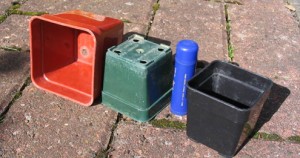In The Greenhouse with Lila Das Gupta
I love the way that every hobby has particular kit associated with it that assumes cult status. Years ago, when I did a brief stint as a bicycle mechanic, everyone lusted after ‘double butted, curly lugged’ Reynold’s tubing on their frames. Trawling round the internet looking for little stones for my cacti, I discover that cactus growers pine after BEF pots .
I’d never heard about them till a week ago, but of course, I immediately saw a need for them and am now becoming a bit of an expert.
The origins of BEF pots are lost in the mists of time: some say it stands for “British Engineering Foundry” Philip Barker, who now produces them, thinks they may be the initials of the original owner from Billericay in Essex. (I would be very interested to hear from anyone who can fill me in on BEF’s origins, has any pictures of original designs or any of the moulds, some of which have never been found).
One thing is certain, they are particularly good for greenhouse growers because they are made of strong polypropylene plastic which has a high tolerance to UV rays and won’t split after a couple seasons.In the past, they were used by professional growers because they were so durable some greenhouse owners report having them for 30 years.
BEF pots are also beloved of cactus growers because they come in various sizes, including 2 inch square pots that are 2 inches deep, perfect for their hobby. (I hear fuchsia fanciers are partial to them as well).
So here comes the bonding bit: you will see from this picture taken by Ian Nartowicz,that as well as being practical in the greenhouse, BEF pots also have a pleasing roundness, solidity and simplicity which make them a bit of a design classic.These are pots from a time when Britain still had a manufacturing industry and a tradition of honest, utilitarian design.

The story of BEF pots also follows the sorry tale of so many British goods.The company no longer exists but the manufacture was taken over by another supplier who seems to have ceased trading.The licence for the pots subsequently passed to Philip Barker, a member of the BCSS, who found a manufacturer who would make them for him in small quantities.
He says: Before I acquired the moulds (sadly some have disappeared completely) they had been owned by at least two others. It was rumoured a few years ago that the pots would be lost for good because sales had become so low. I was given the opportunity to buy about two years ago and as a long time member of the BCSS wanted to keep these outstanding pots going as long as possible. There is simply nothing to compare to them anywhere. The pots have never had a mass market probably due to the high quality.
I’ve just ordered a selection of sizes to see which ones suit my purposes best.There is a corner of my greenhouse that will be forever BEF. (For a list of sizes and prices e-mail Philip Barker [email protected] or Telephone 01942 256440 )
I am reading Asian Vegetables: A guide to growing fruit, vegetables and spices from the Indian sub-continent by Sally Cunningham. (Eco-Logic Books) Sally is a professional gardener who has worked at Ryton Organic Gardens and Kew.The growing instructions are excellent with information on how to buy these vegetables and tell if they are fresh as well.There are a few quibbles though: the index of suppliers doesn’t tell you who sells what, so that’s another few sessions on Google. For the price, the book is rather cheaply produced thin end papers and unimaginative design. I would like to have seen some recipes included too.Still, if you want to grow South Asian Vegetables in your greenhouse this is a good place to start.A companion book I also recommend is Monisha Bharadwaj’s invaluable ‘The Indian Kitchen’, which features individual ingredients used in Indian cooking – where they come from, their cultural significance and a couple of recipes to try.
Enjoy!


